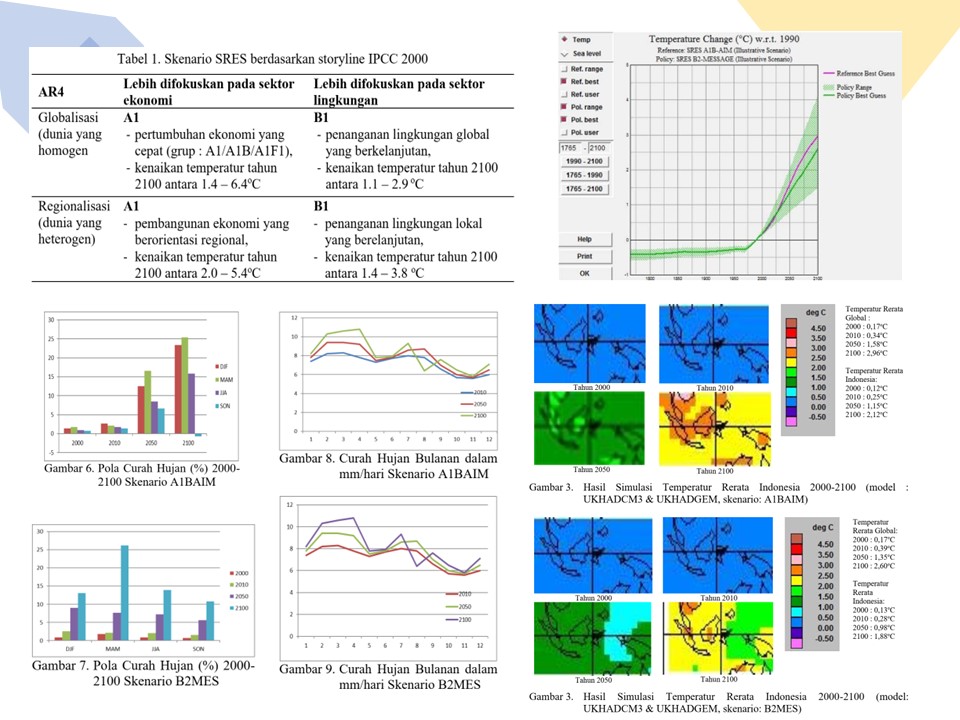Magicc-Scengen Modeling As Strategic Reference For Climate Change Mitigation And Adaptation In Fisheries And Maritime Sector
DOI:
https://doi.org/10.46252/jsai-fpik-unipa.2023.Vol.7.No.3.315Keywords:
adaptation, Magicc-Scengen, mitigation, rainfall, temperatureAbstract
The rise of global surface temperature is predicted to increase the rainfall and runoff. Long-term changes in rainfall will affect the water resource, thus also influencing the fisheries and maritime sector. Understanding the global climate change and their effects, especially in Indonesia as one of the environmental condition parameters, is a part of the strategy for mitigation and adaptation towards climate change, and it is important to do early to support the sustainable development of Indonesia. Magicc-Scengen v5.3 is one of the widely-used climate models. Magicc is used in the projection of sea level and temperature, while Scengen is used to produce the regional climate change scenario with the resolution of 2.5°×2.5° latitude and longitude. This study aims to determine the climate change level especially the air temperature and rainfall in Indonesia using Magicc-Scengen model (global circulation model UKHADCM3 and UKHADGEM) using A1-BAIM and B2-MES scenarios. According to the Magicc-Scengen simulation model, in the year 2100, the global temperature will change from 2.5°C (B2-MES) towards 3°C (A1-BAIM). In Indonesia, the maximum change of temperature will occur on the A1-BAIM scenario, which is 2.12°C, distributed across Sumatra and Kalimantan. Moreover, on B2-MES scenario, the maximum temperature change is 1.88°C. The simulation results also show a rainfall escalation, from 25.4 towards 26.2%, in March-April-May (MAM) period. The A1-BAIM scenario determines that the highest rainfall will occur in MAM (for the year of 2050 and 2100), while B2-MES scenario determines that the rainfall pattern varies widely, in which the highest of it in 2050 will occur on December-January-February (DJF). However, for the year 2100, the highest rainfall will occur on MAM.
Downloads
References
Ashofteh, P-S., Haddad, O. B., Marino, M.A. (2016). Performance Evaluation of a Developed Hybrid AOGCM Model under Climate Change. Journal of Irrigation and Drainage Engineering, 142(12), 16-68.
Imani, T., Delghandi, M., Emamgholizadeh, S., Ganji-Noroozi, Z. (2023). Evaluating uncertainty in climate change impacts on peak discharge and flood volume in the Qaran Talar watershed, Iran. Journal of Water and Climate Change, 00 [0], 1-14.
IPCC. (2000). Emissions Scenarios. A Special Report of Working Group III of The IPCC. Cambridge University Press. Cambridge, U.K.
IPCC. (2018). Global Warming of 1.5°C. An IPCC Special Report on the impacts of global warming of 1.5°C above pre-industrial levels and related global greenhouse gas emission pathways, in the context of strengthening the global response to the threat of climate change, sustainable development, and efforts to eradicate poverty. In Press.
Kimoto, M., Knight, J. R., Latif, M., Rosati, A. (2012). Systematic Estimates of Initial-Value Decadal Predictability for Six AOGCMs. Journal Of Climate. 25, 1827-1846.
KLHK. (2020). Roadmap Nationally Determined Contribution (NDC) Adaptasi Perubahan Iklim. Kementerian Lingkungan Hidup dan Kehutanan Republik Indonesia.
Kurniawan, E., Herizal, dan Budi Setiawan. (2009). Proyeksi Perubahan Iklim Berdasarkan Skenario IPCC SRES Dengan Menggunakan Model AOGCM CCSR/NIES (Stasiun Pemantau Atmosfer Global Bukit Kototabang-Sumatera Barat). Buletin Meteorologi Klimatologi dan Geofisika, 5 [2].
Moegni,N., Rizki, A., Prihantono, G. (2014). Adaptasi Nelayan Perikanan Laut Tangkap Dalam Menghadapi Perubahan Iklim. Jurnal Ekonomi dan Studi Pembangunan, 15 [2], 182-189.
Nakicenovic, N. et al. (2000). Special Report on Emissions Scenarios: A Special Report of Working Group III of the Intergovernmental Panel on Climate Change, Cambridge University Press, Cambridge, U.K., 599 pp. Available online at: http://www.grida.no/climate/ipcc/emission/index.htm
Purnomo, A. H., S. H. Suryawati, I. M. Radjawane dan K. O. Sembiring. (2015). Perubahan Iklim di Wilayah Pesisir. Konsep dan Aplikasi Strategi Adaptasi. Bandung (ID). Penerbit ITB.
Randall, D. A., and Coauthors, (2007). Climate models and their evalution. Climate Change 2007: The Physical Science Basis, S. Solomon et al., Eds., Cambridge University Press, 589–662.
Runtuboi, F., Nugroho, J., & Rahakratat, Y. (2018). Biomassa and Accumulation Carbon on Seagrass Enhalus Acroides in Gunung Botak Bay Coastal, West Papua. Jurnal Sumberdaya Akuatik Indopasifik, 2(2), 91–102. https://doi.org/10.30862/jsai-fpik-unipa.2018.Vol.2.No.2.47
Susandi, A. (2010). Bencana Perubahan Iklim Global dan Proyeksi Perubahan Iklim Indonesia. [email protected].
Susandi, A. (2006). Projection of Climate Change over Indonesia using MAGICC/SCENGEN Model. [email protected].
Susilawati. (2021). Dampak Perubahan Iklim Terhadap Kesehatan. Electronic Journal Scientific of Environmental Health And Diseases, 1[2], 25-31.
Thornton. Philip K, Polly J. Ericksen, Mario Herrero and Andrew J. Challinor. (2014). Climate variability and vulnerability to climate change: a review. Global Change Biology. John Wiley & Sons Ltd., 20, 3313-3328.
Wigley, T.M.L., Raper, S.C.B., Hulme, M. dan Smith, S. (2008). The MAGICC/SCENGEN Climate Scenario Generator: Version 5.3, Technical Manual. Climatic Research Unit. Norwich, U.K.
Watts, D. (1997). Human Dimensions of Global Change Impacts on Water Resources in Tropical Islands. The Globe Issue 40, 13-14.
Yogiswara, I.G.N.A. dan Sutrisna, I K. (2021). Pengaruh Perubahan Iklim Terhadap Hasil Produksi Ikan Di Kabupaten Badung. E-Jurnal EP Unud, 10 [9], 3613 – 3643.

Downloads
Published
How to Cite
Issue
Section
License
Copyright (c) 2023 Syafrudin Raharjo, Suhaemi Suhaemi, Marhan Marhan

This work is licensed under a Creative Commons Attribution-ShareAlike 4.0 International License.

















